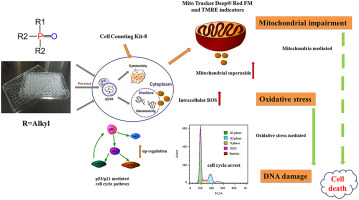Chemosphere ( IF 8.1 ) Pub Date : 2020-01-24 , DOI: 10.1016/j.chemosphere.2020.126026 Shengwu Yuan 1 , Kongrui Zhu 2 , Mei Ma 2 , Xiaoshan Zhu 3 , Kaifeng Rao 4 , Zijian Wang 5

|
Phosphorus-containing flame retardants (PFRs) have been frequently detected in various environmental samples at relatively high concentrations and are considered emerging environmental pollutants. However, their biological effects and the underlying mechanism remain unclear, especially alkyl-PFRs. In this study, a battery of in vitro bioassays was conducted to analyze the cytotoxicity, oxidative stress, mitochondrial impairment, DNA damage and the involved molecular mechanisms of several selected alkyl-PFRs. Results showed that alkyl-PFRs induced structural related toxicity, where alkyl-PFRs with higher logKow values induced higher cytotoxicity. Long-chain alkyl-PFRs caused mitochondrial and DNA damage, resulting from intracellular reactive oxygen species (ROS) and mitochondrial superoxide overproduction; while short-chain alkyl-PFRs displayed adverse outcomes by significantly impairing mitochondria without obvious ROS generation. In addition, alkyl-PFRs caused DNA damage-induced cell cycle arrest, as determined by flow cytometry, and transcriptionally upregulated key transcription factors in p53/p21-mediated cell cycle pathways. Moreover, compared to the control condition, triisobutyl phosphate and trimethyl phosphate exposure increased the sub-G1 apoptotic peak and upregulated the p53/bax apoptosis pathway, indicating potential cell apoptosis at the cellular and molecular levels. These results provide insight into PFR toxicity and the involved mode of action and indicate the mitochondria is an important target for some alkyl-PFRs.
中文翻译:

含烷基磷的阻燃剂诱导的体外氧化应激,线粒体损伤和G1期细胞周期停滞。
含磷阻燃剂(PFR)经常在各种环境样品中以相对较高的浓度检测到,并被认为是新兴的环境污染物。然而,它们的生物学效应和潜在机制仍不清楚,尤其是烷基-PFR。在这项研究中,体外电池进行了生物测定,以分析几种选定的烷基PFR的细胞毒性,氧化应激,线粒体损伤,DNA损伤和涉及的分子机制。结果表明,烷基-PFR诱导结构相关的毒性,其中具有较高logKow值的烷基-PFR诱导较高的细胞毒性。长链烷基-PFRs引起线粒体和DNA损伤,其原因是细胞内活性氧(ROS)和线粒体超氧化物的过量生产;而短链烷基PFR则通过显着损害线粒体而没有明显的ROS生成而显示出不良结果。此外,通过流式细胞术确定,烷基PFR引起DNA损伤诱导的细胞周期停滞,并在p53 / p21介导的细胞周期途径中转录上调关键转录因子。而且,与控制条件相比,磷酸三异丁酯和磷酸三甲酯的暴露增加了亚G1细胞凋亡峰并上调了p53 / bax细胞凋亡途径,表明在细胞和分子水平上潜在的细胞凋亡。这些结果提供了对PFR毒性和所涉及的作用方式的了解,并表明线粒体是某些烷基PFR的重要靶标。











































 京公网安备 11010802027423号
京公网安备 11010802027423号